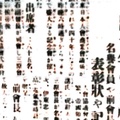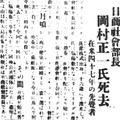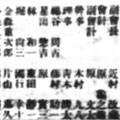In the last chapter, I covered the topic of prefectural associations (Kenjinkai). The focus of this chapter is the Japanese American Association (Nihonjinkai) that supported the Japanese American community. The significance and deep connection of the Japanese American Association to the Nikkei community in Seattle is evidenced by the almost daily mentions of Nihonjinkai in The North American Times. I will share some excerpts from those articles here.1
The History of the Japanese Association
Genji Mihara, the chair of the Nihonjinkai (Nissho or Hokubei Nihonjinkai Shogyo Kaigisho) commented on the organization’s history at its 40th anniversary.
“The 40th anniversary of the founding of Nissho, Chairman Genji Mihara” (May 24, 1939 issue)
We established our organization on February 11, 1900, with the aim of promoting and extending the rights of fellow Japanese. There were 50 or so founding members, 3 directors, and 15 trustees. In 1905, the organization changed its name to the Japanese Association of Washington (Washington-shu Nihonjinkai) and implemented a representative system. On May 1, 1910, it split into two bodies and the Japanese Association of Seattle (Shiatoru Nihonjinkai) became a separate entity.
The two organizations later re-merged to create the Hokubei Nihonjinkai (Nikkai), the Japanese Association of North America, on May 1, 1921, and elected four directors as well as fifty councilors. Nikkai later introduced the representative system in 1926. On February 19, 1931, Nikkai merged with Shogyo Kaigisho under the new name, the Hokubei Nihonjinkai Shyogyo Kaigisho (Nissho), the name still in use today, with 6 directors and 75 councilors selected in general elections.
The association was engaged in a wide range of activities including the acquisition of ship hulls during the European war, efforts to amend the Japan-US Treaty, litigations pertaining to naturalization, appeals opposing anti-Japanese land laws, dealings with State Legislatures, community fundraising, welcoming of the training fleet, facilitating the donation of stone lanterns, and issues relating to the second Sino-Japanese war. The Nikkai was central to the lives of Japanese Americans, working to advance the status and welfare of the community, promoting social education, and supporting commercial and industrial activities to promote economic development.
Today, reflecting on the past 40 years, I feel a strong sense of history. I would like to express heartfelt respect for those who served as directors and councilors, as well as members who supported us over the years. I hope that we continue to work together to promote the welfare of our community.
Mr. Sumiyoshi Arima, the President of the North American Times, made the following comments about the association’s history in his column “Hokubei Shunjyu.”
“Commemorating the 40 years anniversary of the founding of Nissho” (July 20, 1939 Issue)
The changing attitudes of fellow citizens toward the Nihonjinkai mirrored the historical transition of the Nikkei community. When the Japanese first started to immigrate to the United States, the association was rife with internal political and factional conflicts. Over time, the association’s central focus and responsibilities changed from petitioning the Japanese government during commercial development, to supporting the Americanization movement, and finally to addressing permanent residency.
The Japanese Association and the Chamber of Commerce merged around the time. The focus shifted from economic development to economic restructuring. As population decline became evident, the attitude naturally changed from one of aggressive advancement to retreat and preservation. The issue of the second generation emerged around the time.
Nissho redefined itself as a service organization and was recognized as such. Newly established social and educational departments replaced the diplomatic and moral sections. The people associated with the organization also changed significantly. [...] We should always remember the sacrifice and hard work of the predecessors who built the Japanese American community.
Officer Elections of the Hokubei Nihonjinkai (Nikkai)
“Nikkai General Meeting Minutes” (February 4, 1918 issue)
On February 3 at 2:00 PM the meeting commenced at the Japanese Building Hall. President Arima, 94 attendees, reports from each committee member, 50 councilors chosen in the election (names published).
Mr. Tetsuo Takahashi, Mr. Heiji Okuda, and Mr. Masajiro Furuya were elected as chairman candidates in the Officer elections. Below three individuals each were elected as Vice President, Treasurer and Director candidates.
New directors were elected at Hokubei Nihonjinkai temporary council
On February 5, the elected councilors of the Board of Directors of Nikkai made the following decisions.
1. The election of the Chairman and Vice Chairman
2. Runoff elections for officers (President, Vice President, Treasurer, Director candidate runoff)
3. The election of the Communications Representative
4. Director and Deputy Director Elections
The results were– Chairman: Chuzaburo Ito, Vice Chairman: Munefusa Takahashi, President: Tetsuo Takahashi, Vice President: Sumikiyo Arima, Director: Seiro Shibugaki, Treasurer: Tsuneyoshi Kikutake. This was reported in the February 6, 1918 issue.
The then-President of the North American Times, Mr. Sumikiyo Arima, wrote a personal essay titled “Some Things I Have in Mind” (February 6, 1918 issue) regarding the Board of Directors election results.
Mr. Chuzaburo Ito, with his moderate temperament and common sense, is a superb choice for the chair. Vice Chair Mr. Takahashi and Director Mr. Shibugaki, both rising young talents, will show their capabilities in the future. President Tetsuo Takahashi and Treasurer Tueyoshi Kikutake are both well-respected and need no additional endorsement. It is unfortunate that Mr. Matsumi and Mr. Tsukuno retired, citing their old age.
My election as Vice Chair was an error by the Board of Directors. The board made a mistake by choosing me as the chair last spring, and I barely fulfilled my duty. As such I expressed my reluctance to be chosen as the chair, hoping that promising newcomers will take over the duty. However, to my disappointment, the board ignored my refusal and chose me as Vice Chair.
I am a newspaper writer wholly dedicated to expressing critical opinions. I am more suited to objectively supervise, criticize, and encourage as an outsider. As an executive, various situations will not allow for independent criticism. This is the reason I am resigning as a Vice Chair. It is important to elect the right person to ensure the satisfaction and commitment of those chosen.
The chairman is not part of the senior management nor the administration. His task is merely to organize the proceedings of the General Meeting and therefore it’s not difficult or constraining for a newspaper reporter to work in the capacity. I suggest that a newspaper reporter can be elected as a chair but not for a management role. It is better to elect those who volunteer to be the Chair, Vice Chair, board member or treasurer to ensure their satisfaction and active participation.
The 1919 election result for the Board of Directors, Chairman, and other officers were published in the issues of March 6 and 11. Mr. Sumiyoshi Arima became Chairman, as he desired. Mr. Kanaya Okajima was elected President, Mr. Chuzaburo Ito became Vice President, Mr. Matataro Hirajima assumed the role of treasurer, and Mr. Seiro Shibugaki joined as a Director.
To be continued...
1. All article excerpts are from The North American Times unless noted otherwise.
*The English version of this series is a collaboration between Discover Nikkei and The North American Post, Seattle’s bilingual community newspaper. This article was originally publishd in Japanese on November 30, 2022 in The North American Post.
© 2022 Ikuo Shinmasu










